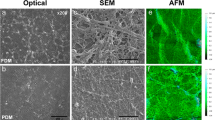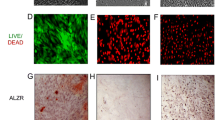Abstract
During their commitment and differentiation toward the osteoblast lineage, mesenchymal stem cells secrete a unique extracellular matrix (ECM) that contains large quantities of glycosaminoglycans (GAGs). Proteoglycans (PGs) are major structural and functional components of the ECM and are composed of a core protein to which one or more glycosaminoglycan sugar chains (GAGs) attach. The association of BMP2, a member of the TGF-β super-family of growth factors, and a known heparin-binding protein, with GAGs has been implicated as playing a significant role in modulating the growth factor’s in vitro bioactivity. Here we have characterised an osteoblast-derived matrix (MX) obtained from decellularised MC3T3-E1 cell monolayers for its structural attributes, using SEM and histology, and for its functional ability to maintain cell growth and viability. Using a combination of histology and anion exchange chromatography, we first confirmed the retention of GAGs within MX following the decellularisation process. Then the binding specificity of the retained GAG species within the MX for BMP2 was examined using a BMP2-HBP/EGFP (BMP2 Heparin-Binding Peptide/Enhanced Green Fluorescent Protein) fusion protein. The results of this study provide further evidence for a central role of the ECM in the regulation of BMP2 bioactivity, hence on mesenchymal stem cell commitment to the osteoblast lineage.








Similar content being viewed by others
References
Ai X, Do AT, Lozynska O, Kusche-Gullberg M, Lindahl U, Emerson CP Jr (2003) QSulf1 remodels the 6-O sulfation states of cell surface heparan sulfate proteoglycans to promote Wnt signaling. J Cell Biol 162:341–351
Armstrong L, Hughes O, Yung S, Hyslop L, Stewart R, Wappler I, Peters H, Walter T, Stojkovic P, Evans J et al (2006) The role of PI3K/AKT, MAPK/ERK and NFkappabeta signalling in the maintenance of human embryonic stem cell pluripotency and viability highlighted by transcriptional profiling and functional analysis. Hum Mol Genet 15:1894–1913
Brickman YG, Ford MD, Gallagher JT, Nurcombe V, Bartlett PF, Turnbull JE (1998) Structural modification of fibroblast growth factor-binding heparan sulfate at a determinative stage of neural development. J Biol Chem 273:4350–4359
Coombe DR, Kett WC (2005) Heparan sulfate-protein interactions: therapeutic potential through structure-function insights. Cell Mol Life Sci 62:410–424
Cowan CM, Aalami OO, Shi YY, Chou YF, Mari C, Thomas R, Quarto N, Nacamuli RP, Contag CH, Wu B, Longaker MT (2005) Bone morphogenetic protein 2 and retinoic acid accelerate in vivo bone formation, osteoclast recruitment, and bone turnover. Tissue Eng 11:645–658
Datta N, Holtorf HL, Sikavitsas VI, Jansen JA, Mikos AG (2005) Effect of bone extracellular matrix synthesized in vitro on the osteoblastic differentiation of marrow stromal cells. Biomaterials 26:971–977
Depprich R, Handschel J, Sebald W, Kubler NR, Wurzler KK (2005) Comparison of the osteogenic activity of bone morphogenetic protein (BMP) mutants. Mund Kiefer Gesichtschir 9:363–368
Esko JD, Lindahl U (2001) Molecular diversity of heparan sulfate. J Clin Invest 108:169–173
Fisher MC, Li Y, Seghatoleslami MR, Dealy CN, Kosher RA (2006) Heparan sulfate proteoglycans including syndecan-3 modulate BMP activity during limb cartilage differentiation. Matrix Biol 25:27–39
Fuchs E, Tumbar T, Guasch G (2004) Socializing with the neighbors: stem cells and their niche. Cell 116:769–778
Gallagher JT (1997) Structure-activity relationship of heparan sulphate. Biochem Soc Trans 25:1206–1209
Gama CI, Tully SE, Sotogaku N, Clark PM, Rawat M, Vaidehi N, Goddard WA III, Nishi A, Hsieh-Wilson LC (2006) Sulfation patterns of glycosaminoglycans encode molecular recognition and activity. Nat Chem Biol 2:467–473
Ghosh-Choudhury N, Abboud SL, Nishimura R, Celeste A, Mahimainathan L, Choudhury GG (2002) Requirement of BMP-2-induced phosphatidylinositol 3-kinase and Akt serine/threonine kinase in osteoblast differentiation and Smad-dependent BMP-2 gene transcription. J Biol Chem 277:33361–33368
Gospodarowicz D, Lepine J, Massoglia S, Wood I (1984) Comparison of the ability of basement membranes produced by corneal endothelial and mouse-derived Endodermal PF-HR-9 cells to support the proliferation and differentiation of bovine kidney tubule epithelial cells in vitro. J Cell Biol 99:947–961
Hallak LK, Kwilas SA, Peeples ME (2007) Interaction between respiratory syncytial virus and glycosaminoglycans, including heparan sulfate. Methods Mol Biol 379:15–34
Hollinger JO, Schmitt JM, Buck DC, Shannon R, Joh SP, Zegzula HD, Wozney J (1998) Recombinant human bone morphogenetic protein-2 and collagen for bone regeneration. J Biomed Mater Res 43:356–364
Huang W, Carlsen B, Rudkin GH, Shah N, Chung C, Ishida K, Yamaguchi DT, Miller TA (2001) Effect of serial passage on gene expression in MC3T3-E1 preosteoblastic cells: a microarray study. Biochem Biophys Res Commun 281:1120–1126
Hwang NS, Varghese S, Puleo C, Zhang Z, Elisseeff J (2007) Morphogenetic signals from chondrocytes promote chondrogenic and osteogenic differentiation of mesenchymal stem cells. J Cell Physiol 212:281–284
Jackson RA, Murali S, van Wijnen AJ, Stein GS, Nurcombe V, Cool SM (2007) Heparan sulfate regulates the anabolic activity of MC3T3-E1 preosteoblast cells by induction of Runx2. J Cell Physiol 210:38–50
Jeon O, Song SJ, Kang SW, Putnam AJ, Kim BS (2007) Enhancement of ectopic bone formation by bone morphogenetic protein-2 released from a heparin-conjugated poly(L-lactic-co-glycolic acid) scaffold. Biomaterials 28:2763–2771
Kreuger J, Spillmann D, Li JP, Lindahl U (2006) Interactions between heparan sulfate and proteins: the concept of specificity. J Cell Biol 174:323–327
Lian JB, Stein GS, Javed A, van Wijnen AJ, Stein JL, Montecino M, Hassan MQ, Gaur T, Lengner CJ, Young DW (2006) Networks and hubs for the transcriptional control of osteoblastogenesis. Rev Endocr Metab Disord 7:1–16
Long S, Truong L, Bennett K, Phillips A, Wong-Staal F, Ma H (2006) Expression, purification, and renaturation of bone morphogenetic protein-2 from Escherichia coli. Protein Expr Purif 46:374–378
Manton KJ, Sadasivam M, Cool SM, Nurcombe V (2006) Bone-specific heparan sulfates induce osteoblast growth arrest and downregulation of retinoblastoma protein. J Cell Physiol 209:219–229
Marie P, Debiais F, Cohen-Solal M, de Vernejoul MC (2000) New factors controlling bone remodeling. Joint Bone Spine 67:150–156
Morimoto-Tomita M, Uchimura K, Werb Z, Hemmerich S, Rosen SD (2002) Cloning and characterization of two extracellular heparin-degrading endosulfatases in mice and humans. J Biol Chem 277:49175–49185
Murakami N, Saito N, Takahashi J, Ota H, Horiuchi H, Nawata M, Okada T, Nozaki K, Takaoka K (2003) Repair of a proximal femoral bone defect in dogs using a porous surfaced prosthesis in combination with recombinant BMP-2 and a synthetic polymer carrier. Biomaterials 24:2153–2159
Paine-Saunders S, Viviano BL, Economides AN, Saunders S (2002) Heparan sulfate proteoglycans retain Noggin at the cell surface: a potential mechanism for shaping bone morphogenetic protein gradients. J Biol Chem 277:2089–2096
Paredes R, Arriagada G, Cruzat F, Villagra A, Olate J, Zaidi K, van Wijnen A, Lian JB, Stein GS, Stein JL, Montecino M (2004) Bone-specific transcription factor Runx2 interacts with the 1alpha,25-dihydroxyvitamin D3 receptor to up-regulate rat osteocalcin gene expression in osteoblastic cells. Mol Cell Biol 24:8847–8861
Park K, Min BH, Han DK, Hasty K (2007) Quantitative analysis of temporal and spatial variations of chondrocyte behavior in engineered cartilage during long-term culture. Ann Biomed Eng 35:419–428
Proudfoot AE (2006) The biological relevance of chemokine-proteoglycan interactions. Biochem Soc Trans 34:422–426
Rauch F, Lauzier D, Croteau S, Travers R, Glorieux FH, Hamdy R (2000) Temporal and spatial expression of bone morphogenetic protein-2, -4, and -7 during distraction osteogenesis in rabbits. Bone 27:453–459
Ruppert R, Hoffmann E, Sebald W (1996) Human bone morphogenetic protein 2 contains a heparin-binding site which modifies its biological activity. Eur J Biochem 237:295–302
Sidhu KS, Lie KH, Tuch BE (2006) Transgenic human fetal fibroblasts as feeder layer for human embryonic stem cell lineage selection. Stem Cells Dev 15:741–747
Stone B (2002) Dispatches from the last frontier of molecular and cell biology: biosynthesis of polysaccharides and proteoglycans of the cell surface and extracellular matrix. IUBMB Life 54:161–162
Sugahara K, Kitagawa H (2002) Heparin and heparan sulfate biosynthesis. IUBMB Life 54:163–175
Takada T, Katagiri T, Ifuku M, Morimura N, Kobayashi M, Hasegawa K, Ogamo A, Kamijo R (2003) Sulfated polysaccharides enhance the biological activities of bone morphogenetic proteins. J Biol Chem 278:43229–43235
Takahashi Y, Yamamoto M, Tabata Y (2005) Enhanced osteoinduction by controlled release of bone morphogenetic protein-2 from biodegradable sponge composed of gelatin and beta-tricalcium phosphate. Biomaterials 26:4856–4865
Tumova S, Woods A, Couchman JR (2000) Heparan sulfate proteoglycans on the cell surface: versatile coordinators of cellular functions. Int J Biochem Cell Biol 32:269–288
Turnbull J, Powell A, Guimond S (2001) Heparan sulfate: decoding a dynamic multifunctional cell regulator. Trends Cell Biol 11:75–82
Urist MR (1965) Bone: formation by autoinduction. Science 150:893–899
Vandermoere F, El Yazidi-Belkoura I, Slomianny C, Demont Y, Bidaux G, Adriaenssens E, Lemoine J, Hondermarck H (2006) The valosin-containing protein (VCP) is a target of Akt signaling required for cell survival. J Biol Chem 281:14307–14313
Vandermoere F, El Yazidi-Belkoura I, Demont Y, Slomianny C, Antol J, Lemoine J, Hondermarck H (2007) Proteomics exploration reveals that actin is a signaling target of the kinase Akt. Mol Cell Proteomics 6:114–124
Vogelin E, Jones NF, Huang JI, Brekke JH, Lieberman JR (2005) Healing of a critical-sized defect in the rat femur with use of a vascularized periosteal flap, a biodegradable matrix, and bone morphogenetic protein. J Bone Joint Surg Am 87:1323–1331
Wurzler KK, Emmert J, Eichelsbacher F, Kubler NR, Sebald W, Reuther JF (2004) [Evaluation of the osteoinductive potential of genetically modified BMP-2 variants]. Mund Kiefer Gesichtschir 8:83–92
Zhao B, Katagiri T, Toyoda H, Takada T, Yanai T, Fukuda T, Chung UI, Koike T, Takaoka K, Kamijo R (2006) Heparin potentiates the in vivo ectopic bone formation induced by bone morphogenetic protein-2. J Biol Chem 281:23246–23253
Acknowledgements
The authors would like to acknowledge the grant support from Singapore’s Agency for Science Technology and Research (A-STAR), the Biomedical Research Council (BMRC) of Singapore and the Institute of Molecular and Cell Biology (IMCB), Singapore.
Author information
Authors and Affiliations
Corresponding author
Rights and permissions
About this article
Cite this article
Grünert, M., Dombrowski, C., Sadasivam, M. et al. Isolation of a native osteoblast matrix with a specific affinity for BMP2. J Mol Hist 38, 393–404 (2007). https://doi.org/10.1007/s10735-007-9119-0
Received:
Accepted:
Published:
Issue Date:
DOI: https://doi.org/10.1007/s10735-007-9119-0




